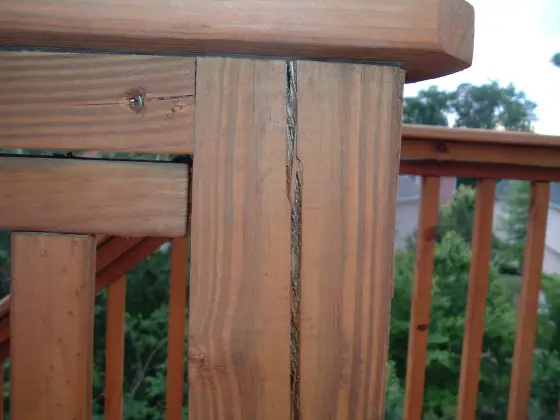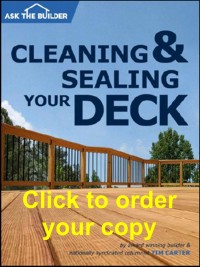Treated Lumber – Clean & Seal

Look at the giant crack in this 4x4. The post was probably fine when installed, but the loss of moisture created tension within the lumber and caused the wood to split apart. PHOTO CREDIT: Suzanne Wieczorek
DEAR TIM: What do you know about treated lumber? I purchased treated lumber for a deck many years ago. At that time, the lumber companies said it would last a lifetime. Now they are saying that the lumber should be treated and sealed on a regular basis, even brand new lumber. Is this true? If so, why? What is the best way to clean and seal my treated lumber? R. A.
DEAR R. A.: I am by no means an expert on treated lumber, however there are several things that I can tell you which may shock and surprise you. Number one, your treated lumber must be sealed. The lifetime warranty that many of the treated lumbers carry covers rotting and insect infestation. The warranty does not cover appearance characteristics.
Wood is one of the most fascinating building materials that I have ever had the pleasure of working with. You can do just about anything with it. But, as with all things, you must take the good with the bad. The only bad quality that wood possesses, in my opinion, is that it is not dimensionally stable. The size of a piece of wood changes, often dramatically, in response to the amount of water which it contains at any given time.
Treated lumber, by its very nature, has massive quantities of moisture in it when it leaves the treatment plant. Untreated boards are stacked inside a giant vacuum chamber. The air in the chamber (and from inside the cells of the wood) is sucked out. The chamber is flooded with water which contains chemical preservatives. The chamber is then pressurized. The chemicals, because of this process, penetrate deeply into the wood. Often pieces of wood are so saturated with these preservatives, that it squirts out when driving a nail.
Wind and sun action begin a slow, destructive process that results in cracks, twisting, warping, cupping, and discoloration of any type of lumber. The top layer of wood fibers exposed to the sun's ultraviolet light can be rapidly destroyed. These effects can be minimized by blocking sunlight and slowing the evaporation of the water from the wood. That is why you must seal treated lumber. Some treated lumbers are available with factory applied sealants. Those that are not must be sealed immediately.
Cleaning and sealing treated lumber must be done on a periodic basis. There are many different cleaners and sealers that you can choose to use. Some are good and some not so good.
First, let's talk about cleaners and brighteners. Some cleaners and brighteners contain chlorine bleach. Chlorine bleach is not a great thing to use on treated lumber or any lumber for that matter. It can leave your deck looking quite white and unnatural.
Bleach can also harm surrounding vegetation. Consider using a cleaner that contains oxygen bleach. Oxygen bleach is very effective at removing dirt, mildew , and algae. It also does a great job of removing the sun damaged wood fibers. When using a cleaner, always brush it with a stiff scrub brush to get the best results. The brushing action removes the top layer of damaged wood fibers.
Treated lumber sealants can be very confusing. I'll bet that you have seen water repellents, sealers, preservatives, and clear finishes on store shelves. They are not all the same by any stretch of the imagination. To begin with, try to avoid using "all purpose" products. Stick with products that are designed specifically for treated lumber or exterior wood.
When selecting a sealer, try to choose one that is a penetrating water repellent. Look for ones that are formulated using synthetic oils and resins. Look for products that have three things in particular: mildewcides, algaecides, and ultraviolet (UV) blockers. Products that contain these three things (or any combination) are much better than a simple wood sealer or water repellent. Don't underestimate the importance of the UV blocker.
Remember, treated lumber needs to be sealed immediately after installation. If you wait any length of time, all kinds of problems will begin to occur. Quality products are available which can be applied directly to your new treated lumber. Don't hesitate to apply them!
| Message from Tim:
Years ago while researching a column about cleaning decks, I discovered the wonders of Oxygen Bleach. It is perhaps the 'greenest' cleaner I know of as it uses oxygen ions to break apart stains, dirt and odor molecules. There are no harsh chemicals, and it works on just about anything that is water washable. I decided to create my own special blend using ingredients made in the USA. In fact, the raw materials in the active ingredient are food-grade quality registered with the FDA. I call my product Stain Solver. I urge you to use it to help clean your cedar shakes. You will be amazed at the results! |

2 Responses to Treated Lumber – Clean & Seal